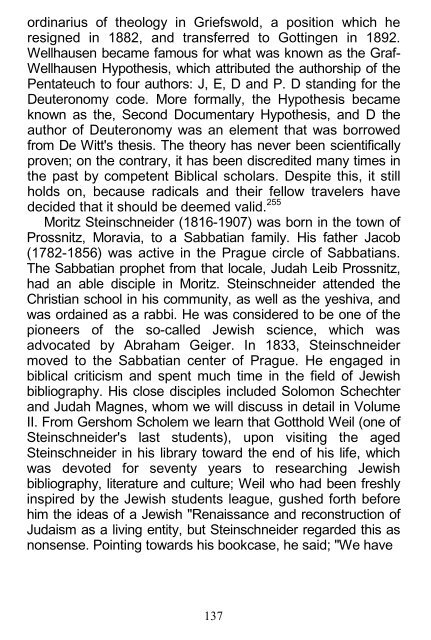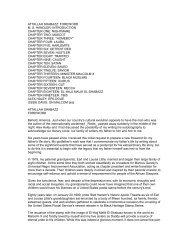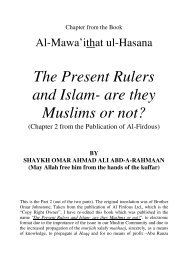You also want an ePaper? Increase the reach of your titles
YUMPU automatically turns print PDFs into web optimized ePapers that Google loves.
ordinarius of <strong>the</strong>ology in Griefswold, a position which he<br />
resigned in 1882, and transferred <strong>to</strong> Gottingen in 1892.<br />
Wellhausen became famous for what was known as <strong>the</strong> Graf-<br />
Wellhausen Hypo<strong>the</strong>sis, which attributed <strong>the</strong> authorship of <strong>the</strong><br />
Pentateuch <strong>to</strong> four authors: J, E, D and P. D standing for <strong>the</strong><br />
Deuteronomy code. More formally, <strong>the</strong> Hypo<strong>the</strong>sis became<br />
known as <strong>the</strong>, Second Documentary Hypo<strong>the</strong>sis, and D <strong>the</strong><br />
author of Deuteronomy was an element that was borrowed<br />
from De Witt's <strong>the</strong>sis. The <strong>the</strong>ory has never been scientifically<br />
proven; on <strong>the</strong> contrary, it has been discredited many times in<br />
<strong>the</strong> past by competent Biblical scholars. Despite this, it still<br />
holds on, because radicals and <strong>the</strong>ir fellow travelers have<br />
decided that it should be deemed valid. 255<br />
Moritz Steinschneider (1816-1907) was born in <strong>the</strong> <strong>to</strong>wn of<br />
Prossnitz, Moravia, <strong>to</strong> a Sabbatian family. His fa<strong>the</strong>r Jacob<br />
(1782-1856) was active in <strong>the</strong> Prague circle of Sabbatians.<br />
The Sabbatian prophet from that locale, Judah Leib Prossnitz,<br />
had an able disciple in Moritz. Steinschneider attended <strong>the</strong><br />
Christian school in his community, as well as <strong>the</strong> yeshiva, and<br />
was ordained as a rabbi. He was considered <strong>to</strong> be one of <strong>the</strong><br />
pioneers of <strong>the</strong> so-called Jewish science, which was<br />
advocated by Abraham Geiger. In 1833, Steinschneider<br />
moved <strong>to</strong> <strong>the</strong> Sabbatian center of Prague. He engaged in<br />
biblical criticism and spent much time in <strong>the</strong> field of Jewish<br />
bibliography. His close disciples included Solomon Schechter<br />
and Judah Magnes, whom we will discuss in detail in Volume<br />
II. From Gershom Scholem we learn that Gotthold Weil (one of<br />
Steinschneider's last students), upon visiting <strong>the</strong> aged<br />
Steinschneider in his library <strong>to</strong>ward <strong>the</strong> end of his life, which<br />
was devoted for seventy years <strong>to</strong> researching Jewish<br />
bibliography, literature and culture; Weil who had been freshly<br />
inspired by <strong>the</strong> Jewish students league, gushed forth before<br />
him <strong>the</strong> ideas of a Jewish "Renaissance and reconstruction of<br />
Judaism as a living entity, but Steinschneider regarded this as<br />
nonsense. Pointing <strong>to</strong>wards his bookcase, he said; "We have<br />
137




